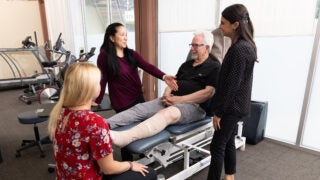
The admission packets for the 2018 fall admits have been mailed. (USC Photo/Susanica Tam)
USC sees record number of applicants for fall 2018 admission
A landslide of outstanding applications raises the bar for admits, as average GPA and standardized test scores continue climbing
An unprecedented surge in applications has made 2018 a historic year for USC admissions. A record 64,000 students applied, a 14 percent increase from the year before and the biggest jump in two decades.

“We’ve never had a harder time selecting which applicants to put in the classroom,” said Timothy Brunold, USC’s dean of admission. “We could hardly believe the numbers, and now we’re feeling the pain of having to turn away so many candidates we admire. At the same time, it’s a breakthrough year for USC.”
Impact on USC acceptance rate
Academic achievement increased as the average GPA and standardized test scores continued climbing. The record number of applicants forced the USC Office of Admission to accept just 13 percent – the lowest ever for USC. The admission rate dropped a full 3 percentage points.
Of those admitted, 26 percent are from underrepresented minority groups, while 69 percent are students of color.
The immense increase in the number of high school students seeking admission to USC was the biggest since 1999 with the exception of 2012, when the introduction of the Common Application caused a spike in applications.
USC conducts a hands-on, personal admissions process some universities no longer provide.
The boom in applications comes after a decade of expanded recruitment efforts. University admissions staff members visit about 2,200 high schools every year.
“We know the high school counselors, and they know us,” Brunold said. “As some of their best and well-known students head to USC, there’s increased awareness and excitement about us in those communities.”
More than a third of the admitted class are straight-A students, and 60 percent have standardized test scores in the 99th percentile.
“Grades and numbers are a starting point,” Brunold said. “We want a diverse class, and we think about which students our faculty want to teach, which students want to solve intractable problems. It’s a search-and-selection process that lines up with the university’s strategic plan, and the mature young people we admit bring something to the student body.”
Brunold noted high interest in new degree programs at several schools, as well as the draw of student life enhancements like the massive USC Village, a living/learning environment for 2,500 students and a welcome addition to the neighborhood around the University Park Campus.
The count: a breakdown of USC’s fall admissions
The pool of students admitted for the fall 2018 semester are diverse and high-achieving. They come from all 50 states, the District of Columbia, Puerto Rico, Guam and American Samoa. (Enrollment commitments are due May 1; the makeup of the enrolled class may differ.) Of the admitted students:
- 85 percent have standardized test scores at or above the 95th percentile.
- 60 percent of the admitted freshmen enrolled in seven or more Advanced Placement and/or International Baccalaureate courses in high school.
- Nearly 800 are non-native English speakers.
- 25 percent are Asian.
- 16 percent are Latino.
- 6 percent are African-American.
- 26 percent are from underrepresented minority populations (black, Latino, Native American and some who report multiple ethnicities).
- 3,287 different high schools are represented.
- California is the most-represented state, at 39 percent. Outside California, the leading U.S. states for students are, in order: Texas, New York, Illinois, Washington and Florida.
- International students, from 87 countries, make up 17 percent of those admitted. Outside the U.S., the most-represented countries are China, India, South Korea, Canada and Brazil.



